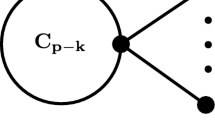Abstract
Traditionally, the quality of orthogonal planar drawings is quantified by either the total number of bends, or the maximum number of bends per edge. However, this neglects that in typical applications, edges have varying importance. In this work, we investigate an approach that allows to specify the maximum number of bends for each edge individually, depending on its importance.
We consider a new problem called FlexDraw that is defined as follows. Given a planar graph G=(V,E) on n vertices with maximum degree 4 and a function \(\operatorname{flex}: E \longrightarrow\mathbb{N}_{0}\) that assigns a flexibility to each edge, does G admit a planar embedding on the grid such that each edge e has at most \(\operatorname{flex}(e)\) bends? Note that in our setting the combinatorial embedding of G is not fixed. FlexDraw directly extends the problem β-embeddability asking whether G can be embedded with at most β bends per edge.
We give an algorithm with running-time O(n 2) solving FlexDraw when the flexibility of each edge is positive. This includes 1-embeddability as a special case and thus closes the complexity gap between 0-embeddability, which is \(\mathcal{NP}\)-hard to decide, and 2-embeddability, which is efficiently solvable since every planar graph with maximum degree 4 admits a 2-embedding except for the octahedron. In addition to the polynomial-time algorithm we show that FlexDraw is \(\mathcal{NP}\)-hard even if the edges with flexibility 0 induce a tree or a union of disjoint stars.












Similar content being viewed by others
References
Biedl, T., Kant, G.: A better heuristic for orthogonal graph drawings. Comput. Geom. 9(3), 159–180 (1998)
Di Battista, G., Liotta, G., Vargiu, F.: Spirality and optimal orthogonal drawings. SIAM J. Comput. 27(6), 1764–1811 (1998)
Di Battista, G., Tamassia, R.: On-line maintenance of triconnected components with SPQR-trees. Algorithmica 15, 302–318 (1996)
Di Battista, G., Tamassia, R.: On-line planarity testing. SIAM Journal on Computing 25(5), 956–997 (1996)
Ford, L.R., Fulkerson, D.R.: Maximal flow through a network. Can. J. Math. 8, 399–404 (1956)
Garg, A., Tamassia, R.: On the computational complexity of upward and rectilinear planarity testing. SIAM J. Comput. 31(2), 601–625 (2001)
Gutwenger, C., Mutzel, P.: A linear time implementation of SPQR-trees. In: Graph Drawing. Lecture Notes in Computer Science, vol. 1984, pp. 77–90. Springer, Berlin/Heidelberg (2001)
Henzinger, M.R., Klein, P.N., Rao, S., Subramanian, S.: Faster shortest-path algorithms for planar graphs. J. Comput. Syst. Sci. 55(1), 3–23 (1997)
Liu, Y., Marchioro, P., Petreschi, R., Simeone, B.: Theoretical results on at most 1-bend embeddability of graphs. Acta Math. Appl. Sin. 8, 188–192 (1992)
Liu, Y., Morgana, A., Simeone, B.: A linear algorithm for 2-bend embeddings of planar graphs in the two-dimensional grid. Discrete Appl. Math. 81(1–3), 69–91 (1998)
Miller, G.L., Naor, J.: Flow in planar graphs with multiple sources and sinks. SIAM J. Comput. 24(5), 1002–1017 (1995)
Morgana, A., de Mello, C.P., Sontacchi, G.: An algorithm for 1-bend embeddings of plane graphs in the two-dimensional grid. Discrete Appl. Math. 141(1–3), 225–241 (2004)
Tamassia, R.: On embedding a graph in the grid with the minimum number of bends. SIAM J. Comput. 16(3), 421–444 (1987)
Whitney, H.: Congruent graphs and the connectivity of graphs. Am. J. Math. 54(1), 150–168 (1932)
Acknowledgements
We thank the anonymous reviewers for their comments, which helped us to improve the presentation of our paper.
Author information
Authors and Affiliations
Corresponding author
Additional information
A preliminary version of this article has appeared as T. Bläsius, M. Krug, I. Rutter and D. Wagner, Orthogonal Graph Drawing with Flexibility Constraints in Proc. 18th International Symposium on Graph Drawing (GD’2010).
Rights and permissions
About this article
Cite this article
Bläsius, T., Krug, M., Rutter, I. et al. Orthogonal Graph Drawing with Flexibility Constraints. Algorithmica 68, 859–885 (2014). https://doi.org/10.1007/s00453-012-9705-8
Received:
Accepted:
Published:
Issue Date:
DOI: https://doi.org/10.1007/s00453-012-9705-8




